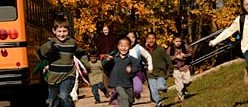The Adult Training and Education Survey (ATES) 2010 Pilot Test and the Spanish Cognitive Interviews for the 2010 National Household Education Survey (NHES) Study Draft Questionnaires
System Clearance for Cognitive, Pilot and Field Test Studies
NHES 2011 Spanish Cog Interviews 2010 PFI_Enrolled_alternate
The Adult Training and Education Survey (ATES) 2010 Pilot Test and the Spanish Cognitive Interviews for the 2010 National Household Education Survey (NHES) Study Draft Questionnaires
OMB: 1850-0803
OMB No. XXXX-XXXX Approval Expires XX/XX/XXXX
The National Household Education Survey A Survey about Students’ and Families’ Experience with Their Schools |



Thank you for helping us with this survey. Based on the information we received from your household in your last survey, we’re asking you to complete this final step.

S
U.S.
Department of Education
National
Center for Education Statistics
Instructions
Please answer all the survey questions thinking about this child or youth.
|
We are authorized to collect this information by Section 9543, 20 US Code. You do not have to provide the information requested. However, the information you provide will help the Department of Education’s ongoing efforts to learn more about the educational experiences of children and families. There are no penalties should you choose not to participate in this study. Your responses are protected by federal statute (P.L. 107-279, Title I, Part E, Sec. 183). Your answers may be used only for statistical purposes and may not be disclosed, or used, in identifiable form for any other purpose except as required by law [Education Sciences Reform Act of 2002 (ESRA 2002) Public Law 107-279, Section 183].
This voluntary survey is estimated to take an average of 20 minutes, including time for reviewing instructions, and completing and reviewing the collection of information. An agency may not conduct or sponsor, and a person is not required to respond to, a collection of information unless it displays a currently valid OMB control number. Send comments regarding this burden estimate or any other aspect of this collection of information, including suggestions for reducing this burden, to: Andrew Zukerberg National Center for Education Statistics, U.S. Department of Education, 1990 K Street NW, Room 9036, Washington, DC 20006-5650. Do not return the completed form to this address.
1 |
► Thank you for your help with the previous survey your household completed.
► Answer all the survey questions thinking about the child listed below:
1. This child’s grade may be shown above. To confirm this child’s grade, please mark or write the grade this child is attending.
If this child is not assigned a specific grade, mark or write the grade he/she would be in at a school with regular grades.
Full-day kindergarten
Partial-day kindergarten

Grade (1 through 12)
Child has not yet started kindergarten


2. Is he/she currently enrolled in advanced placement classes?
No
Yes
Does not apply
3. What type of school does this child attend?
P
 rivate,
Catholic
rivate,
CatholicP
 rivate,
religious
rivate,
religious
but not Catholic
Private, not religious
P
 ublic
school
ublic
school
4. Is it his/her regularly assigned school?
No
Yes
5. Is this school a charter school?
No
Yes
6. Did you move to your current neighborhood so that this child could attend his/her current school?
No
Yes
7 . Did
you consider other schools for this child?
. Did
you consider other schools for this child?
N

 o
oY
 es
es
8. In deciding between schools, did you seek information on the performance of the schools you were considering, like test scores, dropout rates, and so on?
No
Yes
9. Is the school this child attends your first choice, that is, the school you wanted most for him/her to attend?
No
Yes
10. Since the beginning of this school year, has this child been in the same school?
No
Yes
11. In which month did this child start at his/her current school?
 month (1 through 12)
month (1 through 12)
12. How much do you agree or disagree with the following statement:
“This child enjoys school.”
Strongly agree
Agree
Disagree
Strongly disagree

13. Please tell us about this child’s grades during this school year. Overall, across all subjects, what grades does this child get?
Mostly A’s
Mostly B’s
Mostly C’s
Mostly D’s and lower
This child’s school does not give these grades
14. Since the beginning of this school year, how many times have any of this child’s teachers or school staff contacted your household about…
Write ‘0’ if none.
Number
a. |
Behavior problems this child is having in school |
|
b. |
Problems this child is having with school work |
|
c. |
Very good behavior |
|
d. |
Very good school work |
|
14A. Since the beginning of this school year, how many days has this child been absent from school?
 days
days
► Continue with question 15 on the next page.
1 5. Since
starting kindergarten, has this child repeated any grades?
5. Since
starting kindergarten, has this child repeated any grades?
N

 o
o Y
 es
es
16. What grade or grades did he/she repeat?
 Mark
all that apply.
Mark
all that apply.
Elementary through Middle school
Kindergarten
First grade
Second grade
Third grade
Fourth grade
Fifth grade
Sixth grade
Seventh grade
Eighth grade
High school
Ninth grade - freshman
Tenth grade - sophomore
Eleventh grade - junior
Twelfth grade - senior
17. Has this child ever had the following experiences?
M ark
ONE box for each item below.
ark
ONE box for each item below.
|
|
No ▼ |
Yes ▼ |
a. |
An out of school suspension |
|
|
b. |
An in school suspension not counting detentions |
|
|
c. |
Been expelled from school |
|
|

18. How far do you expect this child to go in his/her education?
 Mark
ONE only.
Mark
ONE only.
Complete less than a high school diploma
Graduate from high school
Attend a vocational or technical school after high school
Attend two or more years of college
Earn a bachelor’s degree
Earn a graduate degree or professional degree beyond a bachelor's
19. How would you describe his/her work at school?
 Mark
ONE only.
Mark
ONE only.
Excellent
Above average
Average
Below average
Failing

19A. Some students take school-related courses over the internet. Is this child receiving any instruction this way?
N

 o
oYes
19B. Is that instruction provided by any of the following places?
M ark
all that apply.
ark
all that apply.
Your local public school
A charter school
Another public school
A private school
A college, community college, or university
Someplace else—Specify:
19C. Is there a charge or fee for that instruction?
No
Yes
► Continue with section 2, question 20 on the next page.
20. Since the beginning of this school year, how many times has any adult in this child’s household done any of the following things at this child’s school?
Write ‘0’ if none.
|
|
Number |
|
a. |
Attended a school or class event, such as a play, dance, sports event, or science fair |
|
|
b. |
Served as a volunteer in this child’s classroom or elsewhere in the school. |
|
|
c. |
Attended a general school meeting, for example, an open house, or a back-to-school night. |
|
|
d. |
Attended a meeting of the parent-teacher organization or association. |
|
|
e. |
Gone to a regularly scheduled parent-teacher conference with this child’s teacher. |
|
|
f. |
Participated in fundraising for the school. |
|
|
g. |
Served on a school committee……………………… |
|
|
h. |
Met with a guidance counselor in person. |
|
|
i. |
Other. S |
|
|


22. During this school year, has your family received any of the following:
a. Notes or emails specifically about this child from his/her teachers or school administrators?
No
Yes
b. Newsletters, memos, emails, or notices addressed to all parents?
No
Yes
c. Phone calls specifically about this child from his/her teachers or school administrators?
No
Yes
23. How well has this child’s school been doing the following things during this school year?
a. Letting you know how this child is doing in school between report cards.
Very well
Just ok
Not very well
Does not do it at all
b. Providing information about how to help this child with homework.
Very well
Just ok
Not very well
Does not do it at all
c . Providing
information about why this child is placed in particular groups or
classes.
. Providing
information about why this child is placed in particular groups or
classes.
Very well
Just ok
Not very well
Does not do it at all
d. Providing information on your expected role at this child’s school.
Very well
Just ok
Not very well
Does not do it at all
e. Providing information on how to help this child plan for college or vocational school.
Very well
Just ok
Not very well
Does not do it at all
Does not apply

25. To what extent would you say you are satisfied or dissatisfied with each of the following:
a. The school this child attends this year?
Very satisfied
Somewhat satisfied
Somewhat dissatisfied
Very dissatisfied
b. The teachers this child has this year?
Very satisfied
Somewhat satisfied
Somewhat dissatisfied
Very dissatisfied
c. The academic standards of the school?
Very satisfied
Somewhat satisfied
Somewhat dissatisfied
Very dissatisfied
d. The order and discipline at the school?
Very satisfied
Somewhat satisfied
Somewhat dissatisfied
Very dissatisfied
e. The way that school staff interacts with parents?
Very satisfied
Somewhat satisfied
Somewhat dissatisfied
Very dissatisfied

3. Homework
26. How often does this child do homework, either at home, at an after-school program, or somewhere else outside of school?
Less than once a week
1 to 2 days a week
3 to 4 days a week
5 or more days a week
N

 ever
everChild does not
have homework
27. In an average week, how many hours does this child spend on homework outside of school?
 number of hours per week
number of hours per week
28. How do you feel about the amount of homework this child is assigned?
The amount is about right
It’s too much
It’s too little
28A. How does this child feel about the amount of homework he or she is assigned?
The amount is about right
It’s too much
It’s too little
29. Is there a place in your home that is set aside for this child to do homework?
No
Yes
Child does not do homework at home

30. How often does any adult in your household check to see that this child’s homework is done?
Never
Rarely
Sometimes
Always
31. During this school year, about how many days in an average week does anyone in your household help this child with his/her homework?
Less than once a week
1 to 2 days a week
3 to 4 days a week
5 or more days a week
Never
► Continue with section 4 on the next page.

4. Family Activities
32. In the past week, has anyone in your family done the following things with this child?
M ark
ONE box for each item below.
ark
ONE box for each item below.
|
|
No ▼ |
Yes ▼ |
|||
a. |
Told him/her a story (Do not include reading to this child.) |
|
|
|||
b. |
Done activities like arts and crafts, coloring, painting, pasting, or using clay |
|
|
|||
c. |
Played board games or did puzzles with him/her |
|
|
|||
d. |
Worked on a project like building, making, or fixing something…….. |
|
|
|
||
e. |
Played sports, active games, or exercised together |
|
|
|
||
f. |
Discussed with him/her how to manage time |
|
|
|
||
g. |
Talked with him/her about the family’s history or ethnic heritage |
|
|
|
||

33. In the past week, how many days has your family eaten the evening meal together?
Write ‘0’ if none.
 days
days
34. In the past month, has anyone in your family done the following things with this child?
|
|
|
|
|
||||||||||||||||||||||||||||||||||
|
|
|
|
|||||||||||||||||||||||||||||||||||
► Continue with section 5, question 35 on the next page.
 5.
Child’s Health
5.
Child’s Health
35. In general, how would you describe this child’s health?
Excellent
Very good
Good
Fair
Poor
36A. Has a health professional told you that this child has any of the following conditions?
Mark
ONE box for each item below.

|
|
No ▼ |
Yes ▼ |
a. |
A specific learning disability |
|
|
b. |
An orthopedic impairment |
|
|
c. |
A speech or language delay |
|
|
d. |
A serious emotional disturbance |
|
|
e. |
Deafness or another hearing impairment |
|
|
f. |
Blindness or another visual impairment not corrected with glasses |
|
|
g. |
Mental retardation |
|
|
h. |
Autism |
|
|
i. |
Attention deficit disorder, ADD or ADHD |
|
|
j. |
Pervasive Developmental Disorder or PDD |
|
|
k. |
Another health impairment lasting 6 months or more |
|
|

36B. Did you mark yes to any condition in question 36A?
N

 o
oY
 es
es
37. Is this child receiving services for his/her condition?
N

 o
oY
 es
es
38. Are these services provided by any of the following sources?
M ark
ONE box for each item below.
ark
ONE box for each item below.
|
|
No ▼ |
Yes ▼ |
a. |
Your local school district |
|
|
b. |
A state or local health or social service agency |
|
|
c. |
A doctor, clinic, or other health care provider |
|
|
39. Are any of these services provided through an Individualized Educational Program or Plan (IEP)?
N

 o
oY
 es
es
40. Did any adult in your household work with the service provider or school to develop or change this child’s IEP?
No
Yes
4 1. During
this school year, to what extent have you been satisfied or
dissatisfied with the following aspects of this child’s IEP?
1. During
this school year, to what extent have you been satisfied or
dissatisfied with the following aspects of this child’s IEP?
a. The service provider’s or school’s communication with your family?
Very satisfied
Somewhat satisfied
Somewhat dissatisfied
Very dissatisfied
Does not apply
b. The child’s special needs teacher or therapist?
Very satisfied
Somewhat satisfied
Somewhat dissatisfied
Very dissatisfied
Does not apply
c. The service provider’s or school’s ability to accommodate the child’s special needs?
Very satisfied
Somewhat satisfied
Somewhat dissatisfied
Very dissatisfied
Does not apply
d. The service provider’s or school’s commitment to help your child learn?
Very satisfied
Somewhat satisfied
Somewhat dissatisfied
Very dissatisfied
Does not apply

42. Is this child currently enrolled in any special education classes or services?
No
Yes
43A. Does this child’s condition interfere with his/her ability to do any of the following things?
M ark
ONE box for each item below.
ark
ONE box for each item below.
Child no longer has condition
|
|
No ▼ |
Yes ▼ |
a. |
Learn?................................... …. |
|
|
b. |
Participate in sports, clubs, or other organized activities?......... |
|
|
c. |
Attend school on a regular basis?........................................ |
|
|
d. |
Make friends?............................ |
|
|
► Continue with Section 6, question 44 on the next page.
 6.
Child’s Background
6.
Child’s Background
44. In what month and year was this child born?



month year
45. Where was this child born?
O

 ne
of the 50 United States or the District of
Columbia
ne
of the 50 United States or the District of
Columbia

One of the U.S. territories
(Puerto Rico, Guam, American Samoa, U.S. Virgin Islands, or Mariana Islands)
Another country
46. How old was this child when he/she first moved to the 50 United States or the District of Columbia?

age
47. Is this child of Spanish, Hispanic, or Latino origin?
No
Yes
48. What is this child’s race? You may mark one or more races.
American Indian or Alaska Native
Asian
Black or African American
Native Hawaiian or other Pacific Islander
White

49. For this school year, does this child usually live at this address or another address (for example because of a joint custody arrangement)?
Do not include vacation properties.
Child usually lives at this address
Child usually lives at another address
50. What language does this child speak most at home?

 Mark
ONE only.
Mark
ONE only.
E
 nglish
nglishSpanish
A language other than English or Spanish
English and Spanish equally
English and another language equally
C
 hild
is not able to speak
hild
is not able to speak


51. Is this child currently enrolled in English as a second language, bilingual education, or an English immersion program?
No
Yes
► Continue with Section 7, question 87 on the next page.
7
|
PARENT 1 LIVING IN HOUSEHOLD- Answer questions 88 to 103 about yourself if you are the child’s parent or guardian.
If you are not the child’s parent or guardian, answer questions 88 to 103 about one of this child’s parents or guardians living in the household.
88. Is this parent or guardian the child’s…
Biological parent
Adoptive parent
Step parent
Foster parent
Grandparent
Other guardian
89. Is this person male or female?
Male
Female
90. What is the current marital or partner status of this parent or guardian?
M ark
ONE only.
ark
ONE only.
Married
In a registered domestic partnership or civil union
Living with a partner
Separated
Divorced
Widowed
Never married
9 1. What
was the first language this parent or guardian
learned to speak?
1. What
was the first language this parent or guardian
learned to speak?
M ark
ONE only.
ark
ONE only.
E

 nglish
nglish Spanish
A language other than English or Spanish
English and Spanish equally
English and another language equally
92. What language does this person speak most at home now?
M ark
ONE only.
ark
ONE only.
E

 nglish
nglishSpanish
A language other than English or Spanish
English and Spanish equally
English and another language equally
92A. How difficult is it for him/her to participate in activities at this child's school because he/she speaks a language other than English?
Very difficult
Somewhat difficult
Not at all difficult
92B. Does the school have interpreters who speak his/her native language for meetings or parent-teacher conferences?
No
Yes
92C. Does the school have written materials, such as newsletters or school notices, that are translated into his/her native language?
No
Yes
93. Where was this parent or guardian born?
O


 ne
of the 50 United States or the District of
Columbia
ne
of the 50 United States or the District of
Columbia

One of the U.S. territories
(Puerto Rico, Guam, American Samoa, U.S. Virgin Islands, or Mariana Islands)
Another country
94. How old was this person when he or she first moved to the 50 United States or the District of Columbia?
age
95. Is this person of Spanish, Hispanic, or Latino origin?
No
Yes
96. What is this person’s race? You may mark one or more races.
American Indian or Alaska Native
Asian
Black or African American
Native Hawaiian or other Pacific Islander
White
9 7.
What is the highest grade or level of school
7.
What is the highest grade or level of school
that this parent or guardian completed?
M ark
ONE only.
ark
ONE only.
8th grade or less
High school, but no diploma
High school diploma or equivalent (GED)
Vocational diploma after high school
Some college, but no degree
Associate’s degree (AA, AS)
Bachelor’s degree (BA, BS)
Some graduate or professional education but no degree
Master’s degree (MA, MS)
Doctorate degree (PhD, EdD)
Professional degree beyond Bachelor’s degree (MD, DDS, JD, LLB)
98. Is he or she currently attending or enrolled in a school, college, university, or adult learning center, or receiving vocational education or job training?
No
Yes
99. Which of the following best describes this person’s employment status?
M ark
ONE only.
ark
ONE only.
Employed for pay or income
Self employed
U
 nemployed
or
nemployed
or
o ut
of work
ut
of work
S
 tay
at home
tay
at home
parent
R
 etired
etired Disabled or
unable to work
1 00. (If
employed or self employed) About how many hours per week
does he or she usually work for pay or income,
counting all jobs?
00. (If
employed or self employed) About how many hours per week
does he or she usually work for pay or income,
counting all jobs?



hours
101. (If unemployed or out of work) Has this parent or guardian been actively looking for work in the past 4 weeks?
No
Yes
102. In the past 12 months, how many months (if any) has this person worked for pay or income?

Months
103A. How old is this person?

Age
103B. How old was this person when he or she first became a parent to any child?

Age
Don’t know
PARENT 2 LIVING IN HOUSEHOLD - Answer questions 104 to 120B about a second parent or guardian living in the household.
1 04.
Is there a second parent or guardian living in this household?
04.
Is there a second parent or guardian living in this household?
N

 o
oYes
105. Is this person the child’s…
Biological parent
Adoptive parent
Step parent
Foster parent
Grandparent
Other guardian
106. Is this person male or female?
Male
Female
107.What is the current marital or partner status of this parent or guardian?
M ark
ONE only.
ark
ONE only.
Married
In a registered domestic partnership or civil union
Living with a partner
Separated
Divorced
Widowed
Never married
1
 08.
What was the first language this parent or
guardian learned to speak?
08.
What was the first language this parent or
guardian learned to speak?
M ark
ONE only.
ark
ONE only.
E

 nglish
nglish Spanish
A language other than English or Spanish
English and Spanish equally
English and another language equally
109.What language does this person speak most at home now?
M ark
ONE only.
ark
ONE only.
E

 nglish
nglishSpanish
A language other than English or Spanish
English and Spanish equally
English and another language equally
109A. How difficult is it for him/her to participate in activities at this child's school because he/she speaks a language other than English?
Very difficult
Somewhat difficult
Not at all difficult
109B. Does the school have interpreters who speak his/her native language for meetings or parent-teacher conferences?
No
Yes
109C. Does the school have written materials, such as newsletters or school notices, that are translated into his/her native language?
No
Yes
110. Where was this parent or guardian born?
O


 ne
of the 50 United States or the District of
Columbia
ne
of the 50 United States or the District of
Columbia

One of the U.S. territories
(Puerto Rico, Guam, American Samoa, U.S. Virgin Islands, or Mariana Islands)
Another country
111. How old was this person when he or she first moved to the 50 United States or the District of Columbia?
age
112. Is this person of Spanish, Hispanic, or Latino origin?
No
Yes
113. What is this person’s race? You may mark one or more races.
American Indian or Alaska Native
Asian
Black or African American
Native Hawaiian or other Pacific Islander
White
1 14.
What is the highest grade or level of school that this parent or
guardian completed?
14.
What is the highest grade or level of school that this parent or
guardian completed?
Mark [X] ONE only.
8th grade or less
High school, but no diploma
High school diploma or equivalent (GED)
Vocational diploma after high school
Some college, but no degree
Associate’s degree (AA, AS)
Bachelor’s degree (BA, BS)
Some graduate or professional education but no degree
Master’s degree (MA, MS)
Doctorate degree (PhD, EdD)
Professional degree beyond Bachelor’s degree (MD, DDS, JD, LLB)
115. Is he or she currently attending or enrolled in a school, college, university, or adult learning center, or receiving vocational education or job training?
No
Yes
116. Which of the following best describes this person’s employment status?
M ark
ONE only.
ark
ONE only.
Employed for pay or income
Self employed
U
 nemployed
or
nemployed
or
o ut
of work
ut
of work
S
 tay
at home
tay
at home
parent
R
 etired
etired Disabled or
unable to work
1 17. (If
employed or self employed) About how many hours per week
does he or she usually work for pay or income,
counting all jobs?
17. (If
employed or self employed) About how many hours per week
does he or she usually work for pay or income,
counting all jobs?



hours
118. (If unemployed or out of work) Has this parent or guardian been actively looking for work in the past 4 weeks?
No
Yes
119. In the past 12 months, how many months (if any) has this person worked for pay or income?

months
120A. How old is this person?

Age
120B. How old was this person when he or she first became a parent to any child?

Age
Don’t know
8. Your Household |
121A. Including yourself, how many total people live in this household?
 people
people
121B. Other than the parents or guardians already reported, how many of the following people live in the household with this child?
Write ‘0’ if none.
Example:
B
2
This child’s…. |
Number |
Brother(s) |
|
Sister(s) |
|
Aunt(s) |
|
Uncle(s) |
|
Grandmother(s) |
|
Grandfather(s) |
|
Cousin(s) |
|
Parent’s girlfriend/ boyfriend/ partner |
|
Other relative(s) |
|
Other nonrelative(s) |
|


121. How are you related to this child?
M ark
ONE only.
ark
ONE only.
Mother
(birth, adoptive, step, or foster)
Father
(birth, adoptive, step, or foster)
Aunt
Uncle
Grandmother
Grandfather
Parent’s girlfriend/ boyfriend/ partner
O
 ther
relationship – Specify:
ther
relationship – Specify:

122. What language(s) are spoken at home by the adults in this household?
M ark
all that apply.
ark
all that apply.
English
Spanish or Spanish Creole
French (including Patois, Creole, Cajun)
Chinese
O
 ther
languages – Specify:
ther
languages – Specify:

124. Is this house…
 Mark
ONE
only.
Mark
ONE
only.
Owned or being bought by someone in this household,
Rented by someone in this household, or
Occupied by some other arrangement?
1 25. Other
than this address does anyone in this household currently receive
mail at another address including P.O. Boxes?
25. Other
than this address does anyone in this household currently receive
mail at another address including P.O. Boxes?
No
Yes
126. In the past 12 months did your family ever receive benefits from any of the following programs?
M
 ark
ONE box for each item below.
ark
ONE box for each item below.
|
|
No ▼ |
Yes ▼ |
a. |
Temporary Assistance for Needy Families, or TANF |
|
|
b. |
Your state welfare or family assistance program |
|
|
c. |
Women, Infants, and Children, or WIC |
|
|
d. |
Food Stamps |
|
|
e. |
Medicaid |
|
|
f. |
Child Health Insurance Program (CHIP) |
|
|
g. |
Section 8 Housing assistance |
|
|
1 27.Which
category best fits the total income of all persons in your household
over the past 12 months?
27.Which
category best fits the total income of all persons in your household
over the past 12 months?
Include your own income.
Include money from jobs or other earnings, pensions, interest, rent, Social Security payments, and so on.
$0 to $10,000
$10,001 to $20,000
$20,001 to $30,000
$30,001 to $40,000
$40,001 to $50,000
$50,001 to $60,000
$60,001 to $75,000
$75,001 to $100,000
$100,001 to $150,000
$150,001 or more
131. How many years have you lived at this address?
Write ‘0’ if less than 1 year.
 years
at this address
years
at this address
134. Do you have access to the internet at this address?
No
Yes
136. Is there at least one telephone inside this home that is currently working and not a cell phone?
No
Yes
1
 37. Do
you have a working cell phone?
37. Do
you have a working cell phone?
N

 o
oY
 es
es
138. Of all the telephone calls that you receive are…
all or almost all calls received on cell phones,
some received on cell phones and some on regular phones, or
very few or none on cell phones?
► Continue with Question 139 on the next page.
1 39. We
would like to identify this child’s school so we can include
information about the school in our study.
39. We
would like to identify this child’s school so we can include
information about the school in our study.
Using
the list of schools below mark
 the
box next to the school this child attends. If this child’s
school is not in this list, GO TO question 140.
the
box next to the school this child attends. If this child’s
school is not in this list, GO TO question 140.
|
School Name ▼ |
Address ▼ |
City ▼ |
|
{SCHOOL 1 UP TO ~40 CHARACTERS} |
{ADDRESS 1 UP TO ~30 CHARACTERS} |
{CITY UP TO ~15 CH.} |
|
{SCHOOL 2 UP TO ~40 CHARACTERS} |
{ADDRESS 2 UP TO ~30 CHARACTERS} |
{CITY UP TO ~15 CH.} |
|
{SCHOOL 3 UP TO ~40 CHARACTERS} |
{ADDRESS 3 UP TO ~30 CHARACTERS} |
{CITY UP TO ~15 CH.} |
|
{SCHOOL 4 UP TO ~40 CHARACTERS} |
{ADDRESS 4 UP TO ~30 CHARACTERS} |
{CITY UP TO ~15 CH.} |
|
{SCHOOL 5 UP TO ~40 CHARACTERS} |
{ADDRESS 5 UP TO ~30 CHARACTERS} |
{CITY UP TO ~15 CH.} |
|
{SCHOOL 6 UP TO ~40 CHARACTERS} |
{ADDRESS 6 UP TO ~30 CHARACTERS} |
{CITY UP TO ~15 CH.} |
|
{SCHOOL 7 UP TO ~40 CHARACTERS} |
{ADDRESS 7 UP TO ~30 CHARACTERS} |
{CITY UP TO ~15 CH.} |
|
{SCHOOL 8 UP TO ~40 CHARACTERS} |
{ADDRESS 8 UP TO ~30 CHARACTERS} |
{CITY UP TO ~15 CH.} |
|
{SCHOOL 9 UP TO ~40 CHARACTERS} |
{ADDRESS 9 UP TO ~30 CHARACTERS} |
{CITY UP TO ~15 CH.} |
|
{SCHOOL 10 UP TO ~40 CHARACTERS} |
{ADDRESS 10 UP TO ~30 CHARACTERS} |
{CITY UP TO ~15 CH.} |
|
{SCHOOL 11 UP TO ~40 CHARACTERS} |
{ADDRESS 11 UP TO ~30 CHARACTERS} |
{CITY UP TO ~15 CH.} |
|
{SCHOOL 12 UP TO ~40 CHARACTERS} |
{ADDRESS 12 UP TO ~30 CHARACTERS} |
{CITY UP TO ~15 CH.} |
|
{SCHOOL 13 UP TO ~40 CHARACTERS} |
{ADDRESS 13 UP TO ~30 CHARACTERS} |
{CITY UP TO ~15 CH.} |
|
{SCHOOL 14 UP TO ~40 CHARACTERS} |
{ADDRESS 14 UP TO ~30 CHARACTERS} |
{CITY UP TO ~15 CH.} |
|
{SCHOOL 15 UP TO ~40 CHARACTERS} |
{ADDRESS 15 UP TO ~30 CHARACTERS} |
{CITY UP TO ~15 CH.} |
|
If you found and marked this child’s school in the list provided in question 139 then SKIP this question and return your survey in the postage-paid envelope. Otherwise continue with question 140. |
140. To help us identify the school this child attends, write the name and address of this child’s school in the spaces below.
S |
C |
H |
O |
O |
L |
|
|
a. School name
SCHOOL NAME
b. School street address
NUMBER AND STREET ADDRESS
c. School city
CITY
d. School state
STATE
e. School zip code
ZIP

Commonly Asked Questions
Q: How did you get my address?
A: Your address was randomly selected from among all of the home addresses in the nation. It was selected using scientific sampling methods to represent other households in the U.S.
Q: Why should I take part in this study? Do I have to do this?
A: You represent thousands of other households like yours, and you cannot be replaced. Your answers and opinions are very important to the success of this study. You may choose not to answer any or all questions in this survey. In order for the survey to be representative it is important that you complete and return this questionnaire.
Q: How will the information I provide be used?
A: Your responses will be combined with those of others to produce statistical summaries and reports. Your individual data will not be reported and may not be disclosed, or used, in identifiable form for any other purpose except as required by law [Education Sciences Reform Act of 2002 (ESRA 2002) Public Law 107-279, Section 183].
Q: I have more than one child in my household. Will I receive additional surveys for the other children in my household?
A: No, each household will receive a survey for only one child, even if there are multiple children living in the household. In households with multiple children, one child was randomly selected to be included in the study.
Q: How will my response help the Department of Education?
A: The Department of Education wants to understand the care and early education of children. This survey is the only way that the Department of Education can learn about the types of care and early learning activities children receive. Your responses will be combined with those from other households to inform educators, policy makers, schools and universities about changes in the condition of education in the United States. Reports from past surveys can be found at http://surveys.nces.ed.gov/nhes/.
Q: Who is sponsoring the study? Is this study conducted by the Federal Government?
A: The National Center for Education Statistics, within the Department of Education is authorized to conduct this study (Section 9543, 20 U.S Code). Westat has been contracted to conduct this study. This study has been approved by the Office of Management and Budget, the office that reviews all federally sponsored surveys. The approval number assigned to this study is 1850-0803. You may send any comments about this survey, including its length, to the Federal Government. Write to Andrew Zukerberg, National Center for Education Statistics, U.S. Department of Education, 1990 K Street NW, Room 9036, Washington, DC 20006-5650. You may send e-mail to [email protected].
Q: Who is Westat?
A: Westat is a research company located in Rockville, Maryland. Westat is conducting this survey under contract to the U.S. Department of Education. If you have any questions about the study contact Westat toll-free at 1-888-880-3033.
| File Type | application/msword |
| File Title | WESTAT.DOT |
| Subject | Default Westat Styles |
| Author | Zukerberg, Andrew |
| Last Modified By | #Administrator |
| File Modified | 2010-08-02 |
| File Created | 2010-08-02 |
© 2026 OMB.report | Privacy Policy







